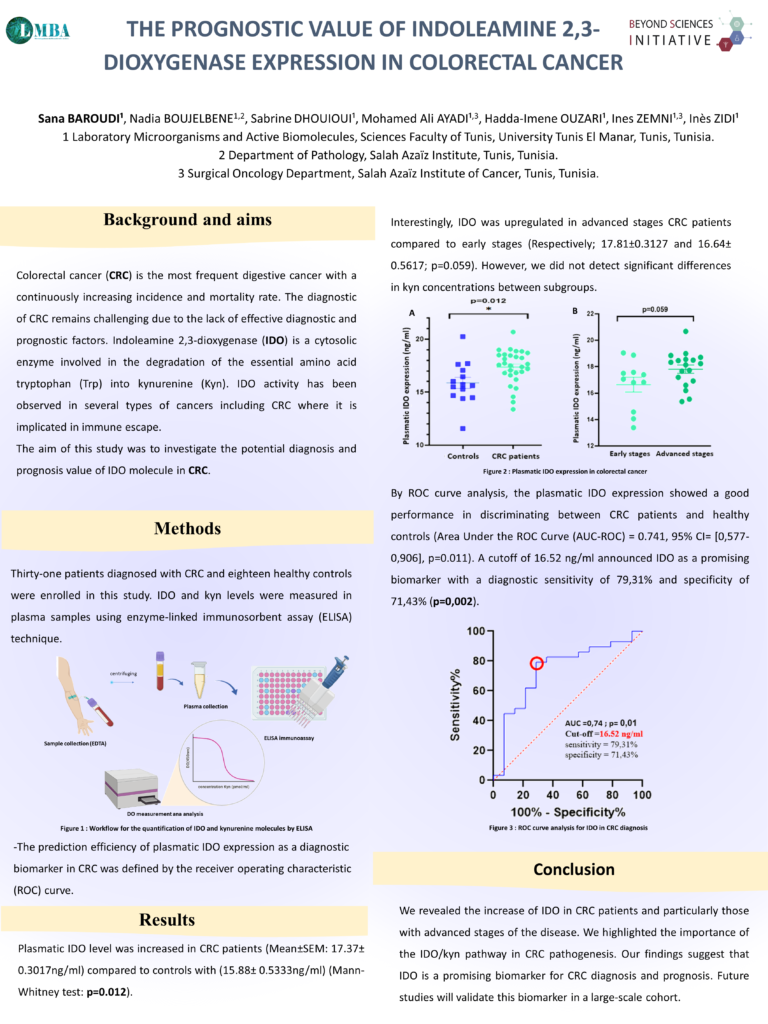Sana Baroudi
Conference 2023 Presentation
Project title
THE PROGNOSTIC VALUE OF INDOLEAMINE 2,3-DIOXYGENASE EXPRESSION IN COLORECTAL CANCER
Authors and Affiliations
Sana BAROUDI¹, Nadia BOUJELBENE1,2, Sabrine DHOUIOUI¹, Mohamed Ali AYADI¹,3, Hadda-Imene OUZARI¹, Ines ZEMNI¹,3, Inès ZIDI¹
1 Laboratory Microorganisms and Active Biomolecules, Sciences Faculty of Tunis, University Tunis El Manar, Tunis, Tunisia.
2 Department of Pathology, Salah Azaïz Institute, Tunis, Tunisia.
3 Surgical Oncology Department, Salah Azaïz Institute of Cancer, Tunis, Tunisia.
Abstract
Background
Indoleamine 2,3-dioxygenase (IDO) is an immunosuppressive enzyme playing an important role in tumor development and progression through immune tolerance via the kynurenine (kyn) pathway. The aim of this study was to investigate the diagnosis and prognosis value of IDO molecule in colorectal cancer (CRC).
Methods
Thirty-one patients diagnosed with CRC and eighteen healthy controls were enrolled in this study. IDO and kyn levels were measured in plasma samples using enzyme-linked immunosorbent assay (ELISA) technique. The prediction efficiency of plasmatic IDO expression as a diagnostic biomarker in CRC was defined by the receiver operating characteristic (ROC) curve.
Results
Plasmatic IDO level was increased in CRC patients (Mean±SEM: 17.37± 0.3017ng/ml) compared to controls with (15.88± 0.5333ng/ml) (Mann-Whitney test: p=0.012). Interestingly, IDO was upregulated in advanced stages CRC patients compared to early stages (Respectively; 17.81±0.3127 and 16.64± 0.5617; p=0.059). However, we did not detect significant differences in kyn concentrations between subgroups. By ROC curve analysis, the plasmatic IDO expression showed a good performance in discriminating between CRC patients and healthy controls (Area Under the ROC Curve (AUC-ROC) = 0.741, 95% CI= [0,577-0,906], p=0.011). A cutoff of 16.52 ng/ml announced IDO as a promising biomarker with a diagnostic sensitivity of 79,31% and specificity of 71,43% (p=0,002).
Conclusions
We revealed the increase of IDO in CRC patients and particularly those with advanced stages of the disease. We highlighted the importance of the IDO/kyn pathway in CRC pathogenesis. Our findings suggest that IDO is a promising biomarker for CRC diagnosis and prognosis. Future studies will validate this biomarker in a large-scale cohort.

